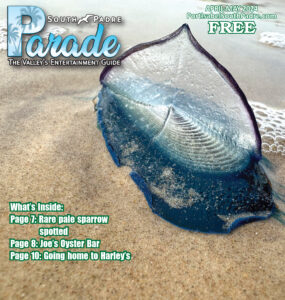By STEVE HATHCOCK
Special to the PRESS
Corpus Christi Texas August 13 1862: A Union flotilla, under the command of Lt. J.W. Kittredge arrived and took up a position off the coast, near where the approach to the harbor bridge is today. Landing under a white flag, Kittredge demanded the right to inspect government buildings that had been vacated at the commencement of hostilities more than a year prior.
Major Alfred M. Hobby, who commanded the cities defenses, denied permission on the grounds that the United States no longer owned any buildings in Corpus Christi or in fact, any other parts of Texas. That ended the negotiations. Kittredge then declared that he would grant the townspeople a 48 hour truce in order to evacuate. Most of the townspeople took this advice to heart traveling a few miles west using anything on wheels to escape.
The bombardment lasted off and on for three days and was mostly a one-sided affair. Casualties were light; a Union sailor was wounded by flying splinters and a Confederate private named Henry Mote was killed.
Humans were not the only creatures to suffer from the effects of the bombardment. Exploding shells killed a cow, a dog and a mule named “Sweetheart.” One resident found his old gray tomcat with his head swollen to twice its natural size and one side of it skinned like he had rubbed up against a buzz saw. A cannon ball caromed off the wall of a saloon before smashing a shelf of whiskey bottles.
The people straggled back to find the town shot up. The lighthouse on the bluff was totally demolished. Outbuildings were destroyed as were several finer residences along the shore. Unexploded cannon balls littered the city. The Federal ships had fired between 400 and 500 rounds of solid and exploding shells.
Since the Confederacy was desperately short of gunpowder, Hobby ordered his men to salvage the powder inside the unexploded cannonballs. But to their surprise (and delight) they found what smelled like bourbon in some of the shells. They thought it was a trick; perhaps the Yankees had poisoned the whisky. But after a few cautious sips, they began to drain all the cannonballs that had liquid contents.
Some weeks later, on Sept. 12, Kittredge was captured at Flour Bluff when he went ashore to trade for supplies. Brought to Corpus Christi, the town he had so recently shot up, he met Major Hobby and was asked about the whisky-filled shells.
For whatever it was worth, this information served to solve a question that had nagged at Kittredge over the past couple of weeks. Kittredge told Hobby that a barrel of bourbon kept for the captain’s mess had been stolen; he had been unable to find where it was hidden, but men coming off the night watch sometimes smelled like they were returning from a tavern.
The sailors, he said, must have emptied some of the cannonballs of gunpowder and refilled them with whisky, to await their turn at night duty. When the bombardment started, they had been sadly forced to fire their whisky-filled shells at the Confederates.
Did some of them really contain whisky? The official reports filed by Hobby and Kittredge do not mention it, but then, that’s not the kind of thing that would be put in an official report; it would have been too hard to explain. It does not matter whether it happened or not. The tale of the whisky-filled cannonballs has been repeated for more one hundred and fifty years and it makes a good story. If it’s true, then Lt Kittredge unwittingly served up the first round for his own going away party.
Want the whole story? Pick up a copy of the Port Isabel-South Padre Press, or subscribe to our E-Edition by clicking here.




Comments